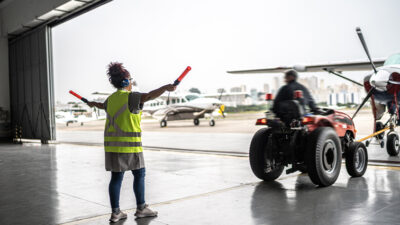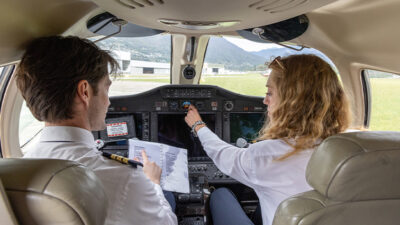Airport Risk Profile – The Vehicle Service Road

Aviation operations conducted on airport premises are replete with hazards that have, over time, been effectively addressed via risk management strategies such as mitigation or elimination. Further, root cause analysis has enabled enlightened operators to reduce enterprise risk by addressing those specific conditions or practices conducive to negative outcomes (accidents, incidents, and injuries).
New for 2023, the FAA is advancing the safety management system (SMS) to the wider airport community. With the introduction of Advisory Circular AC-150/5200-37A1 in its revised form, the FAA now encourages the implementation of an SMS beyond those required to meet specific Part 139 standards and thresholds to the broader airport community as follows:
“Airport operational safety in the airfield environment and the principles apply to all civil airports, when adapted to the size, activity level, staff level, and resources of each facility. Airport operators can apply these principles anywhere on their airports (airside or landside environments) to address safety concerns. Furthermore, while part 139 does not apply to voluntary SMS programs, this AC describes the general SMS framework and serves as a non-binding basis for the development and implementation of voluntary SMS programs for airports.”
The FAA further states that “Part 139 establishes SMS requirements for certain U.S. airports and the FAA encourages airports not subject to the part 139 SMS requirements to implement an SMS voluntarily. The two-pronged approach supports harmonization with ICAO standard in a way that complements existing part 139 airport safety requirements and standards.”
This wide-net approach of enlisting not only a fair number of Part 139 airports2 but encouraging all airports to voluntarily adopt an SMS and move forward with measured implementation, is moving the airport community in the right direction.
This is excellent news for our industry and for advancing safety within the dynamic airport environment, as the risks inherent in day-to-day operations are ever-present and must be actively addressed.
Vehicle Service Roads and Related Risks
One area of significant risk to airport workers is the vehicle service road or “VSR.” The VSR is that snake-like roadway that typically tracks behind the gate and hard stands to allow ground handling service providers (GHSP) to access aircraft to perform services like fueling, catering, baggage transfer, crew transfer, Lav/Water, etc.
The FAA’s Guide to Ground Vehicle Operations3 suggests that operators “Use service roads whenever possible to minimize time spent on taxiways and runways.” Yes, that is good advice. But look out any terminal window and you’ll see an army of ground support and airline service personnel and vehicles around gates and hard stands. This is where the dynamic hazards and risks of harm or damage emerge lie.
Due to increasing passenger travel, different aircraft types, gate retrofitting to support current aircraft types and increased frequency of operations, it takes more workers to service the myriad of operators and operations. Essentially, more people are interacting with moving vehicles and aircraft operations (taxiing in or pushing back) while vehicles traverse the apron area via the VSR.
Over the past several years, there have been numerous accidents and incidents involving VSRs. Some caused serious injuries to ground support workers, presumably wing walking while the AC is pushing off from the gate and walking into the active VSR with their back to the traffic, assuming it will stop. Others involved weather-related hazards such as glare, fog, mist, rain, etc., which limited visibility to both the VSR drivers and ground support personnel.
Take Action To Protect Airport Workers!
This article is a call to action for airports and their airline and ground support partners to develop more advanced mitigations for controlling risk to all personnel working within the airport envelope. These recommendations include:
- Airports including the VSR and associated hazards (seasonal and weather-related) in their risk registers.
- Airlines and ground support organizations enhancing the training of ramp personnel on the numerous hazards and need for enhanced vigilance.
- Ground support workers looking both ways before entering a VSR and not assuming anything.
- Enhancing recurrent training to include a reminder about normalized bad behaviors.
Making Progress on VSR Safety
A positive action comes from the Transportation Research Board (TRB) and its Airport Cooperative Research Program (ACRP), which has recognized this risk and is organizing a synthesis effort to provide updated guidance on this recognized hazard.
“The FAA provides design standards on pavement markings for airport vehicle service roads (VSR), however there is no guidance for developing the layouts of these road systems. Due to the lack of available resources, airport VSR systems are generally left up to the airports for design. Design standards, such as critical object offset, structure offset, and radii dimensions, may vary by terminal size or layout, the level of aircraft activity, and the intended operational use.”
Just because you are required to have an SMS doesn’t mean it’s effective. Hazards and their associated consequences are ever-present and must be addressed through active management and engagement. Vigilance is the word of the day!
References:
1 AC -150/5200-37 issued February 28, 2007.
2 14 CFR 139.401 Subpart E.
3 FAA Guide to Ground Vehicle Operations

AvMaSSI provides safety, security and operational integrity evaluations, consulting and auditing to airlines, airports, charter and corporate operators, OEMs, marine operators, seaports, governments, international agencies and financial institutions the world over. AvMaSSI provides IS-BAO and IS-BAH preparation and audit services and supports Global Aerospace and its SM4 and Vista Elite Programs with focused safety/SMS, security, regulatory compliance and IS-BAO auditing services. AvMaSSI is a proud member of the Global Aerospace SM4 partnership program.
http://www.Avmassi.com
© 2024 Aviation & Marine Safety Solutions International. All Rights Reserved.
Next ArticleRelated Posts

The Effects of a Learning Mindset on Safety Culture
As aviation departments strive to enhance their safety performance, a critical yet often overlooked element is the need to foster a learning-culture mindset. This mindset shift can unlock invaluable opportunities for continuous improvement, employee engagement and creating a resilient safety environment. From a behavioral management perspective, as your company’s learning culture goes, so goes the ongoing success of your SMS.

Safety in Numbers: Trends in Aviation Accidents and Incidents
Every accident is preventable; the problem is that we don’t know how to prevent it until after the accident happens. However, what we can do as an industry is honor the anguish of each event by sharing the information, the mistakes and the outcomes to improve safety for everyone.

